IFA 2018 audio roundup: the best headphones, smart speakers and more
The best providers of sonic booms in Berlin
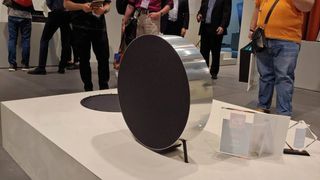
In a show dominated by smart sound systems and headphones, there was also some standout design and genuine breakthroughs to get the real audiophiles excited at this year’s IFA tech expo. Below we pick out the sonic highlights that found a way to be heard above the bedlam in Berlin.
1. Bang & Olufsen Beosound Edge
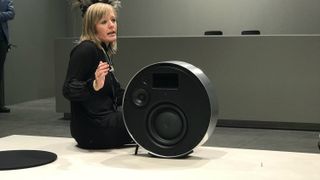
It came as no surprise to find Danish design guru B&O provided the show’s most eye-catching example of audio gear at IFA 2018.
Drawing inspiration from the venerable British pound coin (yes, really), the waist-height spherical smart speaker is designed to be positioned in two ways - like a standing coin on its edge or hanging from a wall like a railway clock via a set of brackets. The brainchild of London-based designer Michael Anastassiades, the Beosound Edge also has a pretty unique control system, requiring you to rock the speaker back or forth to controls its output.
It’s not all about the aesthetics however, with the speaker boasting a huge, full-bodied sound that dazzled during its demo. This is thanks in large part to its ingenious, patented active bass design – with a mechanically controlled recess at the top of the speaker that contracts and widens to match changes in volume.
Able to pump out audio on demand from either side via Bluetooth, Chromecast or Apple AirPlay 2, it sports two 3-quarter inch tweeters, two 4-inch midrange drivers and 10-inch woofer, coupled with six Class D amplifiers. While we’ve got reservations about its quirky controls, it was easily one of the more powerful audio experiences at the show. Priced at £2900 (around $3,765 or AU$5,225), it hits stores in November 2018.
2. Sonos Amp
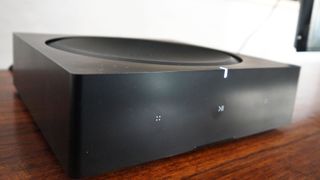
With the re-emergence of record players in recent years, it’s a mystery why it’s taken so long for Sonos to update its Sonos Connect Amp. A decade after its launch, the connected speaker company has finally replaced the model, with the Sonos Amp, packing double the power of its predecessor. Now able to pump out 125 Watts per channel, it can also power up to four speakers instead of two.
Primarily aimed at the custom install market and those who want to bring their own high-end, wired speakers to the multi-room party, the compact, black box-shaped device carries over the touch buttons and vertical light design cues of the recently released Beam and new Play:5 from Sonos.
Get daily insight, inspiration and deals in your inbox
Get the hottest deals available in your inbox plus news, reviews, opinion, analysis and more from the TechRadar team.
New features include AirPlay 2, voice support and HDMI ARC alongside the previously available analogue inputs and it can also be used to add wireless rears to a Sonos home-theatre setup or two Amps can combine for surround sound. Initially only available to the custom install market at the end of the year, it’ll go on sale to the public in February for $599 (around £460 / AU$830).
3. Sony WH-1000XM3
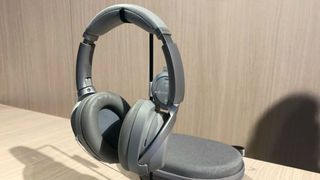
We were big fans of Sony’s Bose-beating noise cancelling cans from earlier this year. the WH-1000XM2, and the Japanese firm hasn't hung around in updating them. Sony claim the new over ears offer a four times greater signal processing performance than its predecessor, thanks to their new built-in Q1 processor.
A three-way switch flicks between no noise cancelling, ambient noise cancelling – which will be ideal for commuting when you need some awareness of your surroundings – and a final full noise cancelling mode, which places an eerie blanket over all outside noise and worked incredibly well on IFA’s noisy show floor.
The sound quality seems similarly tuned to its predecessor, but the headband design has been slimmed down, and there’s also a new Quick Charging function that delivers 5 hours of playback after only 10 minutes of juicing up. The WH-1000XM3 are due out later this month and will retail for approximately $350 (£300 / AU$485).
4. Beyerdynamic Blue Byrd

German audio expert Beyerdynamic were on home turf to unveil its new flagship wireless in-ears. While they may not look hugely different than the raft of linked wireless that have recently flooded the market, their Mosayc sound personalization system goes some way to setting them apart.
The tech allows fine-tuning of the sound to your hearing via an app-based hearing test conducted via your smartphone. Offer up to six hours of playtime from a USB-C charger, the Blue Byrd’s will go sale for around $150 (£115 / AU$205) toward the end of the year.
5. Harman Kardon Citation range

Fresh from their recent takeover by Samsung, Harmon appear to be taking the battle to the likes of Sonos with an impressive range of new smart multi-room speakers.
Coming in a multitude of shapes, sizes and colors, the Google Assistant powered speakers, the range starts with the $199 Citation One – pitched perfectly as an alternative to Sonos One, boasting Google Assistant and Chromecast support and able to handle 24bit/96kHz sources.
While we’ll reserve full judgement for when we can put the range through its paces in our test rooms rather than the show floor, our early experience impressed enough to suggest the range looks capable of upsetting the old guard in the multi-room wars.

Home cinema options include the $1,000 Harman Kardon Bar – a three channel soundbar system that boasts 4K HDR support from its three HDMI inputs. It can also act as a single centre channel when paired with the Harman Kardon Citation Tower speakers, which come as a pair for $2,500, each with a dedicated subwoofer and one with a touchscreen panel.
6. RHA CL2 Planar
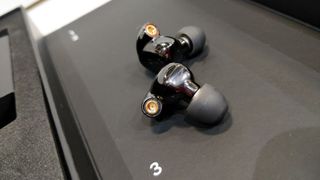
Announced just ahead of the show, the CL2’s were one of the more eagerly awaited headphones to be put through their paces for the first time at IFA. Having the honor of being the first wireless earbuds to feature planar magnetic drivers, something that thus far we’ve only found in high-end open-backed cans, RHA have pulled off a breakthrough that audiophiles have long wished for.
For a premium set of in-ears there’s unsurprisingly a full range of foam and silicone ear tips offered in the box, along with a host of wires provided for purists who still don’t feel Bluetooth quite cuts it for pure fidelity.
For those that do go wireless, RHA claims a creditable 12-hour battery life. On first listen the CL2’s sound incredibly balanced and clear and and appear to offer a genuine first for this form factor. Hold tight for our full review to find out if they sound good enough to justify the meaty $900 (£800 / AU$1250) price tag.
JBL Everest 710GA Google Assistant headphones

As handy as Google Assistant is, having to whip out your handset each time you want to converse with your digital servant can be a bit of a faff. So JBL’s new line of smart headphones are a welcome addition to their roster. For those who like things a bit more discreet, there’s the wireless in-ear Everest 110GA’s, but our favored pair are the new Everest 710GA’s, a gorgeously cushioned pair of wireless cans with an impressively long battery life.
The right-hand can has a set of hardware controls for power, play, pause, volume and track skipping, but the key feature comes with a tap on the left can. A deft touch activates Google Assistant from your connected phone giving you quick info on notifications and the weather. Holding your finger on the sensor for a bit longer gives you the ability to throw a question or command, such as asking for local info or playing a particular playlist.
Slick, with brushed bronze detailing, while not as overt as a set of Beats, the heavy branding on the cans nevertheless may be a bit OTT for more refined listeners, and while it may be something you get used to, the Google Assistant sensor could be a little too easy to accidentally trigger. We’ll be sure to let you know in a full review later in the year.
Also offering ShareMe 2.0 connectivity which allows you to broadcast your tunes to owners of any other Bluetooth headset nearby, and an echo-cancelling mic for improved call audio, the 710GA is set to cost around $300 (around £230 / AU$400).
- IFA 2018 is Europe's biggest tech show. The TechRadar team is in Berlin to bring you all the breaking news and hands-on first impressions of new phones, watches and other tech as they're announced.
Kevin Lynch is a London-born, Dublin-based writer and journalist. The author of Steve Jobs: A Biographic Portrait, Kevin is a regular feature writer for a number of tech sites and the former Technology Editor for the Daily Mirror. He has also served as editor of GuinnessWorldRecords.com and has been a member of the judging panel for the BAFTA British Academy Video Game Awards. Alongside reviewing the latest AV gear, smartphones and computers, Kevin also specialises in music tech and can often be found putting the latest DAWs, MIDI controllers and guitar modellers through their paces. Born within the sound of Bow Bells, Kevin is also a lifelong West Ham fan for his troubles.

